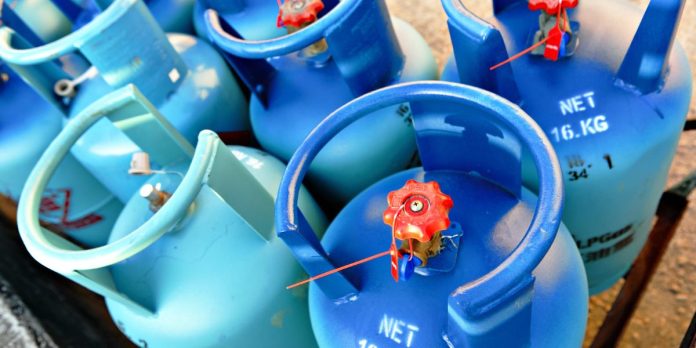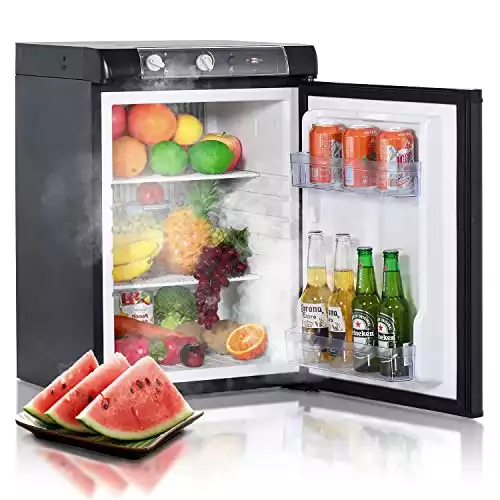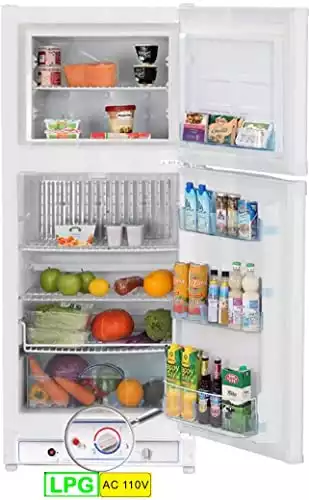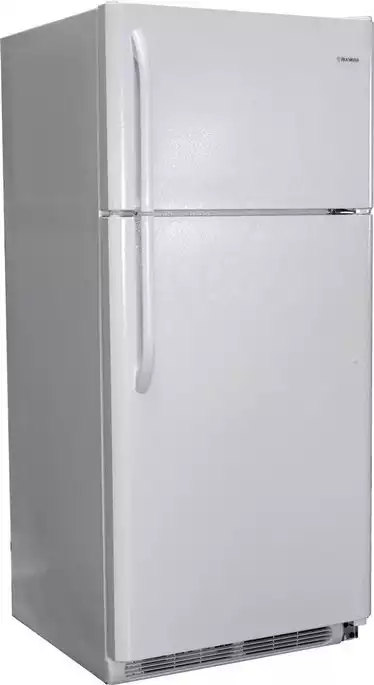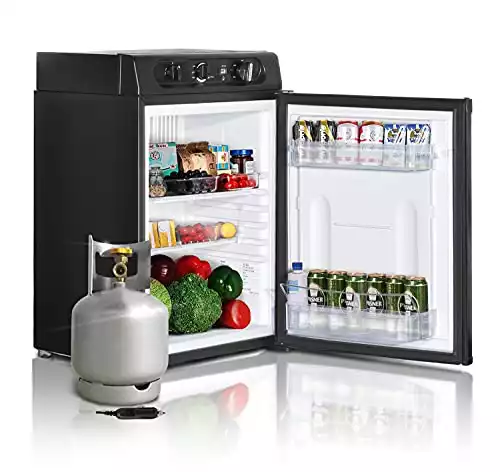A propane refrigerator helps hungry homesteaders keep food fresh without electricity. The best one for you will depend on your family’s size, budget, and unique living situation.
To help get the most bang for your buck, I’ve compared the initial price of various products against their energy efficiency in the long run. By examining other factors, such as size, style, and extra features, I’ve compiled a definitive list of the five best propane refrigerators on the market.
Each one suits different circumstances, so read on to discover the best propane refrigerator for your particular needs.
Best Compact
Smad Caravan Propane Fridge
The Smad Caravan Refrigerator is a small yet powerful unit that won’t cost you an arm and a leg. It’s a convenient and efficient fridge with three power options, so you can stow it in an off-grid cabin or take it on the road for versatile cooling wherever you are.
Propane Refrigerator Reviews
1. Best Overall: SMETA Upright Propane Refrigerator
The SMETA Upright Refrigerator is a spacious unit perfect for energy-conscious off-grid families.
At first glance, the SMETA Upright Propane Refrigerator looks like a regular apartment fridge. It has the same basic shape but is smaller, with 1.6 cubic feet of freezer storage and 4.5 cubic feet of refrigerator space. That should be enough to store a week’s worth of food for a couple or small family.
This unit has a piezo ignition, reversible doors, and wheels for easy transport. However, the best part is its fuel efficiency. The SMETA runs on just 0.28 gallons of propane daily or 8.4 gallons monthly. At propane’s national average of $2.70 per gallon, you can expect to spend roughly $22.70 each month to fuel your unit. That’s a small price to pay for the convenience and peace of mind the SMETA provides.
You won’t have to plug it in to get those crisp, cool drinks you’ve been craving. But if the propane stores run dry, you have that option.
The SMETA can run on 115-volt AC power in addition to propane, so you’ll be golden in a gas shortage. Keep in mind that this unit isn’t cheap, nor is it the largest you can buy. However, it uses less fuel than similar refrigerators and can save energy in the long run.
Pros:
- AC power option
- Freezer
- Lots of storage
Cons:
- No DC power
- Not for large families
2. Best Compact: Smad Caravan Refrigerator
The Smad Caravan fridge is a smaller unit perfect for solo homesteaders or couples.
True to its name, the Smad Caravan Refrigerator can fit comfortably inside your camper or trailer. At just under two feet tall and 18” across, it’s also perfect for tiny homes and small cabins.
The convenient design makes it easy to disassemble, but it isn’t flimsy like some other portable models out there.
You can run the Smad off solar panels with a 12-volt DC option or use it in a regular outlet with 110 volts of AC power. Most importantly, it also delivers efficient propane-powered cooling. You’ll be using just 1.4 gallons of propane per month to run it continuously, with costs sitting around $3.78.
Did I mention that this fridge is adorable? It has just 2.1 cubic feet of capacity, so you won’t be able to store the whole farm inside. However, it is ideal for solo homesteaders or those who don’t keep many perishables around.
You’ll find many of the same features on this tiny fridge that larger options have, including reversible doors and a match-free piezo ignition.
Pros:
- Compact
- Efficient
- Reasonably priced
Cons:
- No freezer
- Limited storage space
3. Best for Big Families: Diamond Elite Extra-Large Refrigerator
The Diamond Elite is a powerful unit suitable for large families and big eaters.
Are you feeding the whole neighborhood? The Diamond Elite propane refrigerator will solve all your storage issues. It’s got 19 total cubic feet of fridge and freezer space, so you’ll be good to go no matter what. You can even hide the ice cream behind some frozen peas so the kids don’t find it.
Discover how big the Diamond Elite really is and check out some features that add to its convenience.
To cool that capacity, you’re looking at 0.35 gallons of propane per day or 10.5 gallons per month. It will run you about $28.35 monthly, which isn’t bad for how much space you get.
The Diamond Elite has a five-year warranty and is the largest CSA-Certified refrigerator in the US market. This means it’s third-party tested and backed to keep food cold no matter what.
This hefty unit is over 65” tall and 36“ wide, so it’s not suitable for smaller spaces. It also weighs nearly 300 pounds but does come on wheels to make moving it a bit easier.
The price tag isn’t any smaller than the fridge itself. Still, extra features like battery-operated interior lighting, crispers, removable shelves, a piezo ignition, and reversible doors make it a worthwhile investment. The only thing that’s really missing is another power option.
Pros:
- Huge capacity
- CSA Certified
- Energy efficient
Cons:
- No electric plug-in option
- Expensive
- Shipping fees
4. Best Budget: SMETA Portable Upright Refrigerator
The SMETA Portable fridge is a smaller, budget-friendly unit you can take on the road.
Unfortunately, propane refrigerators can get pricey. If you want to mitigate the upfront cost, your best bet is a budget-friendly unit like the SMETA Portable Refrigerator.
At just 1.4 cubic feet of capacity, this fridge is definitely the smallest on the list. You’ll only be able to store enough food for a long weekend and maybe a six-pack.
However, many homesteaders enjoy getting creative with food storage.
Using this unit in conjunction with another off-grid refrigeration system may allow you enough wiggle room to meet all your food storage needs without taking a substantial financial hit.
Convenient features like adjustable shelves, a piezo ignition, reversible doors, and a frost-free cooling design help it stand out against the competition.
I’m smitten with the Smeta. Despite its small stature at just over two feet tall, this puppy packs a sizable punch. It’s a three-way unit that runs off propane, 110-volt AC, or 12-volt DC power.
Because the SMETA is so tiny, it doesn’t take that much fuel. You’ll need to shell out around $5.73 monthly to run it continuously. It’s also easy to take apart and carry with you, making it perfect for camping trips or moving around the homestead.
Pros:
- Inexpensive
- Portable
- Three power options
Cons:
- Small capacity
- No freezer option
5. Best Freezer: Techomey Propane Chest Freezer
The Techomey Chest Freezer is a large, top-open unit perfect for hunters and those who need long-term cold storage.
Want to feel like a pirate opening a treasure chest every time you grab some food? The Techomey Chest Freezer is the unit for you.
Ok, so it’s not technically a fridge. However, the Techomey will still work for industrious off-gridders who like to get creative. And if you harvest your own meat, a big deep freeze is practically essential anyway. It allows you to store meat indefinitely, keeping you full and satisfied long after the hunting season is over.
The Techomey unit has a built-in clasp for a padlock so you can secure your food while away. It boasts 6.75 cubic feet of food storage space and a single hanging basket to organize your items. That’s even more space than the SMETA Upright model, and extra features like easy-control temperature knobs and a piezo ignition make it just as convenient.
Like most units on this list, the Techomey can run on 110-volt AC power or propane. It requires around 13 gallons of propane monthly and will run you $35.40 per month. Because it keeps food frozen instead of refrigerated, the Techomey needs more power and more fuel.
However, you might be able to crank up the temperature controls and use it as a fridge instead of a freezer in warm climates. Alternatively, you could change the thermostat to a dedicated refrigerator thermostat to convert your freezer into a fridge full-time. This can help you save on propane and store cold foods you don’t want to freeze, like milk.
Pros:
- Large capacity
- Built-in padlock clasp
- Pirate vibes
Cons:
Propane Refrigerator Buyer’s Guide
It’s natural for off-gridders to use a propane refrigerator. We already use propane generators, propane heaters, and propane cookstoves. And while many of us take steps to preserve meat and other goods without refrigeration, it’s nice to have a backup plan in case we need that cold storage.
With that in mind, what exactly should you look for in a propane refrigerator? It’s vital to understand a bit more about these units and consider your own situation before purchasing one.
How it Works
Propane refrigerators cool with absorption technology rather than a compressor. They contain a mix of ammonia, hydrogen, and oxygen within a single closed-loop system.
When the mixture is heated, ammonia rises and meets the hydrogen. It reacts by pulling heat from inside the fridge, reducing the temperature and cooling it down.
Neat, right? But it does come with a few caveats.
While a propane fridge doesn’t need electricity, the components that allow it to function are heavier, bulkier, and can be finicky. They will be a bit more awkward to handle than electric fridges, and they will perform best in homes that are completely level.
Learn exactly how a propane-powered absorption fridge works.
Size and Shape
Where will your fridge go? It has to fit comfortably in the space you designate. Each unit’s dimensions are listed online, but you must also consider other factors. For example, upright refrigerators need extra clearance on the side to open the door. Chest freezers require space on top to swing open.
Furthermore, some propane fridges need space for vents. Many need to be placed near electrical outlets or batteries to take advantage of alternative power sources. Measure your space and consider all the other factors to ensure your fridge fits well.
Storage Capacity
How much food do you need to store? Appliance manufacturers state that most adults need between four and six cubic feet of refrigerator space to meet their needs, but this amount is highly variable. It doesn’t consider how often you shop, how much food you produce at home, or what concessions you’re willing to make to save on storage space.
Many off-grid homes will need less space because they have gardens for fresh produce.
Some families also utilize techniques like canning and dehydrating to preserve perishables, which can cut down considerably on the necessary capacity. As always, there is no one-size-fits-all solution. Each household will have unique storage needs.
Venting
Most propane refrigerators require venting to the outside world. A vent is an airway that allows carbon monoxide from the propane to travel outside and helps fresh air circulate inside the burner box. Venting keeps your home’s atmosphere clean and ensures a safe temperature in your unit.
Note: Always have a working CO detector to guard against Carbon Monoxide poisoning.
Installing a vent may or may not be a big deal depending on your living situation. Refrigerators don’t usually come with a venting kit, so you’ll need to size and buy one independently. These costs can vary wildly depending on their size and if you install them yourself or pay a contractor.
Price
There’s no getting around the fact that propane refrigerators cost more than electric ones.
Part of the reason for their high cost is that they function differently. They don’t have any moving parts or electrical components, so they’re much easier to maintain and repair. Propane fridges are also highly energy efficient and incredibly convenient, adding to their value over time.
Because your start-up costs will be higher with a propane fridge, picking the proper unit is essential.
Think of ways to save space so you can buy a smaller fridge, conserve propane, and keep your wallet from taking a gigantic hit.
Fortunately, off-gridders are usually pretty good at this. Just consider your fridge a long-term investment that will pay off eventually.
Power Options
Buying a propane fridge with an electric power backup option is wise if you generate any electricity. Most fridges already come with this, and it’s very convenient if you run out of propane. Some will have an AC option, others a DC option. Many units even have both.
Generally speaking, a DC backup is better if your homestead runs on solar and you don’t have an inverter. DC also works with car batteries. AC is better if you have an inverter or get power from a generator. If you want unlimited options, get a three-way unit that can run on AC, DC, and propane.
Propane Use
Propane refrigerators tend to be efficient. On average, a 20-pound propane tank will power your fridge for roughly a month.
Depending on where you live, it will cost anywhere from $10–$30 to refill. Of course, the exact amount you’ll use (and pay for) is highly variable and depends on the unit you buy.
The Diamond Elite will require more than a 20-pound tank of propane per month, while the Smad Caravan won’t even set you back a third of a tank.
Discover how a propane fridge can help reduce power consumption in an off-grid living situation.
If you want to cut costs, buy a smaller unit requiring less propane. You can also just run it less often or turn the temperature controls up a bit higher.
Keeping food slightly cold instead of ice cold will still help preserve it on hot summer days. And if you live somewhere with cold winters, you can invest in suitable food storage containers and simply leave perishables outdoors in the snow.
Maintenance
Propane refrigerators are mechanical and don’t usually require much maintenance. To extend their lifespan and keep everything running smoothly, you should disconnect the gas lines and clean the fridge, the burner element, and the pilot light once or twice a year.
Every unit is different, so read the instruction manual on your chosen fridge to determine the best maintenance practices.
Learn how to take care of your propane fridge and keep everything working correctly.
Features
Depending on your off-grid situation, you might consider fridges with special features. Here are a few I think are nonnegotiable:
- Reversible doors: These allow you to change the direction an upright-style fridge opens, from left to right, or vice versa. They are a great feature if you have clearance to open the door to one side but not the other.
- Safety features: All units on this list have a built-in thermocouple to measure the temperature and shut off the gas if the flame goes out for any reason. Never operate a propane fridge without a working thermocouple, and always follow best safety practices when working with any propane-powered appliance.
- Piezo ignition: The Piezo ignition concept requires no lighter, matches, or electricity. You just have to push a button. As you press down, a manual hammer strike will light your fridge. If you’re always losing lighters like I am, it’s a lifesaver.
Wrapping Up
Switching to a propane fridge can help eliminate your dependence on the power grid and save you money in the long run.
Off-gridders who want a traditional-style fridge should look to the SMETA Upright model, while those searching for something more compact and affordable can choose the versatile Smad Caravan. No matter your living situation or storage needs, there’s a fridge on this list that will fit.

